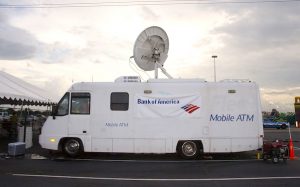
Bank of America Corporation (BofA/BoA) has a generic strategy that requires the company to maximize its profit margins and revenue growth through business models and intensive growth strategies that work with cost minimization. These corporate strategies are based on the company’s business model, which includes online banking as a way to maintain competitiveness through technological innovation. In Michael E. Porter’s model, the generic strategy must align with Bank of America’s goals in developing and strengthening its competitive advantages. On the other hand, in Igor Ansoff’s Matrix, intensive growth strategies must align with the long-term growth and related strategic objectives of the financial services business, accounting for market conditions involving other firms with strong competitive positions, like JPMorgan Chase, Citigroup, and Wells Fargo. The business model establishes the organizational system or design for implementing company strategies and creating value for Bank of America and its customers. With the strategic position as one of the biggest financial services firms, the company and its enterprise architecture serve as an example of successful organizational development for competitive advantage through organizational design that involves the right combination of generic strategy and intensive growth strategies.
Bank of America and its subsidiaries, Merrill (formerly Merrill Lynch), BofA Securities (formerly Bank of America Merrill Lynch), and Bank of America Private Bank (formerly U.S. Trust), employ the same main generic competitive strategy and intensive growth strategies, although some variations occur in strategic implementation. The company’s emphasis is on keeping its financial products/services among the most competitive in the market. With these considerations, this article covers the following topics:
- Bank of America’s Business Model & Design
- Bank of America’s Generic Strategy for Competitive Advantage (Porter’s Model) and Intensive Growth Strategies (Ansoff Matrix)
- Implications involving Bank of America’s Strategies
Bank of America’s Business Model & Design
Bank of America has operations in commercial banking, investment banking, wealth management, and insurance services. Given these financial services, the company’s business model revolves around the provision of products within the financial system, with clientele including individuals and organizations, such as other businesses. Bank of America’s business design involves the following business models:
- Pipeline business model
- Bricks-and-clicks (Click-and-mortar) business model for financial services
Pipeline Business Model. As a pipeline business, Bank of America takes inputs, adds value to these inputs, and provides the final output to target customers. For example, inputs include financial resources and associated services, as well as client information. Bank of America adds value to these inputs through information analysis, expert decision-making, and provision of complementary services to target customers. The pipeline business model typically involves the company’s competitive advantages in a series of activities that develop or create valuable financial products. Bank of America’s generic strategy and intensive growth strategies ensure operational effectiveness in using competitive advantages to deliver value to target customers. The company’s strategies enable customers to access financial resources through this pipeline system with guaranteed efficiency and value optimization.
Click-and-Mortar Business Model. Bank of America applies the click-and-mortar business model through its online operations combined with non-online operations. For example, the company’s website and mobile banking apps allow customers to access financial services online. Also, Bank of America’s generic strategy and intensive growth strategies are reflected in these models. Based on these strategies, the company’s competitive advantages are reinforced through online operations. This business model optimizes Bank of America’s performance by increasing customers’ convenience through online options. The inclusion of advanced information technologies through this business model supports the company’s generic strategy by optimizing operating speed and efficiency, adding to overall customer satisfaction in its financial services. In this regard, this aspect of the business design supports the achievement of Bank of America’s corporate mission and vision statements.
Business Models and BofA’s Strategies and Operations. The combination of the pipeline business model and the click-and-mortar business model facilitates Bank of America’s value chain and its use of VRIO/VRIN core competencies to provide valuable services to target customers. For example, the company uses its pipeline framework as an extensive network to reach all customers, while offering complementary online banking services to enhance the value of this network. Bank of America’s generic strategy, intensive growth strategies, and related competitive advantages define the implementation of these models for optimizing profits and maintaining a strong market position. The banking company’s strategic plans determine possible growth opportunities within the context of these business models. Together with the cost leadership generic strategy and intensive growth strategies, these business models affect how Bank of America’s operations management is structured and implemented. For instance, operations management for human resource development is based on these models’ requirements for human resource support for banking services. Moreover, Bank of America Corporation’s organizational structure is a direct reflection of the pipeline business model and the click-and-mortar business model. Each position and group in the organizational structure is used to ensure that these models generate competitive advantage and value to customers and to the financial services business.
Bank of America’s Generic Strategy, Intensive Growth Strategies, Competitive Advantage
Generic Strategy for Competitive Advantage. Based on Michael E. Porter’s competitive strategy model, Bank of America’s main generic strategy is cost leadership. Cost leadership entails aiming for low costs in providing financial services. Also, as a consequence, the banking company maximizes its profits. This generic strategy also enables Bank of America to optimize its service fees to attract and benefit customers. Based on the SWOT analysis of Bank of America, the company’s competitive advantages are linked to organizational size, which is an offshoot of the cost leadership generic strategy. Although the company is not necessarily a best-cost provider, the generic strategy’s resulting cost efficiencies enhance competitive advantages in commercial banking, investment banking, and wealth management. Bank of America’s operations also reflect some forms of other generic strategies – differentiation and focus strategies. For example, the subsidiary, Bank of America Private Bank emphasizes high quality services as differentiation against competing private banking and trust companies.
Intensive Strategies for Growth. Based on the Igor Ansoff Matrix, Bank of America’s main intensive growth strategy is market penetration. This growth strategy aims to sell more financial services to the company’s current markets. Much of Bank of America’s growth is based on market penetration, leading to the company’s current competitive position as one of the largest banks in the world. Still, the company uses other intensive growth strategies, such as product development and market development, to ensure the competitive growth of the financial services business. For example, product development is applied to offer new financial products to current customers and profit from new revenue streams. In contrast, diversification has minimal significance as an intensive strategy for Bank of America’s growth. The company relies more on market penetration than on diversifying its business outside the financial services industry. The cost leadership generic strategy supports Bank of America Corporation’s market penetration growth strategy. For example, the cost leadership generic strategy ensures the competitive advantage and attractiveness of the company’s financial services, leading to the success of the corporation’s main intensive growth strategies.
Implications of Bank of America’s Business Model and Generic & Intensive Growth Strategies
Bank of America Corporation’s business model and strategies affect each other. The business model determines which intensive growth strategies and generic strategies are most appropriate to maximize the competitive advantages of the banking business. The outcomes of these strategies influence decisions in evolving Bank of America’s business model. Also, the types and characteristics of the company’s financial services impose requirements that keep the business organization’s design involving the pipeline business model, the cost leadership generic strategy, and the market penetration intensive growth strategies. The choice of intensive strategies and corresponding business plans influence Bank of America Corporation’s organizational culture, which affects the human resource support needed for strategic implementation and the success of the company’s business model.
References
- Akan, O., Allen, R. S., Helms, M. M., & Spralls III, S. A. (2006). Critical tactics for implementing Porter’s generic strategies. Journal of Business Strategy, 27(1), 43-53.
- Akhigbe, A., & McNulty, J. E. (2011). Bank monitoring, profit efficiency and the commercial lending business model. Journal of Economics and Business, 63(6), 531-551.
- Allen, R. S., & Helms, M. M. (2006). Linking strategic practices and organizational performance to Porter’s generic strategies. Business Process Management Journal, 12(4), 433-454.
- Amit, R., & Zott, C. (2012). Creating value through business model innovation. MIT Sloan Management Review, 53(3), 41-49.
- Bank of America Corporation – Driving Responsible Growth.
- Bank of America Corporation – Mobile and Online Banking Benefits and Features.
- Bank of America Corporation’s Annual Report for the U.S. Securities and Exchange Commission (Form 10-K).
- Dawei, X., & Peng, Z. (2017). Establishing and Analyzing Commercial Banks’ Carbon Finance Business Revenue Model. In Proceedings of International Symposium on Green Management and Local Government’s Responsibility (p. 31).
- Gurcaylilar-Yenidogan, T., & Aksoy, S. (2018). Applying Ansoff’s Growth Strategy Matrix To Innovation Classification. International Journal of Innovation Management, 22(04), 1850039.
- Hussain, S., Khattak, J., Rizwan, A., & Latif, A. (2014). Interactive effects of Ansoff growth strategies and market environment on firm’s growth. British Journal of Business and Management Research, 1(2), 68-78.
- International Trade Administration of the U.S. Department of Commerce – The Financial Services Industry in the United States.
- Junginger, S. (2015). Organizational design legacies and service design. The Design Journal, 18(2), 209-226.
- Slywotzky, A. J., Morrison, D. J., & Andelman, B. (2007). The profit zone: How strategic business design will lead you to tomorrow’s profits. Crown Business.
- Stamoulis, D., Kanellis, P., & Martakos, D. (2002). An approach and model for assessing the business value of e-banking distribution channels: Evaluation as communication. International Journal of Information Management, 22(4), 247-261.
